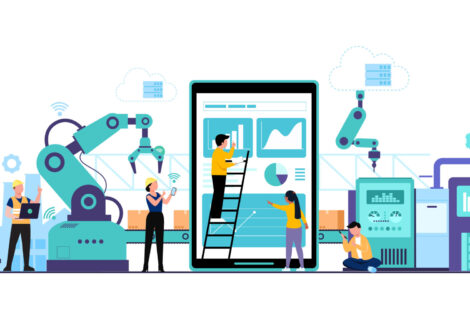How Technology is Preparing Businesses for the Hybrid Working Environment
As businesses up and down the UK consider how to navigate work beyond Covid-19 restrictions, a new way of working that combines remote and office roles is emerging for many firms. The question for many businesses is, ‘What does this mean for our teams, our technology and our trajectory looking ahead?’
Many businesses today, of all shapes and sizes, may well be considering whether a work from home (WFH), return to work, or hybrid approach is right for their companies and teams moving forward.
When asked by the BBC, out of 50 of the UK’s biggest employers, 43 said they would be welcoming a hybrid working approach, with employees encouraged to work remotely for two-three days a week as we move out of lockdown, the BBC revealed in May 2021.
In March 2020, the reliance on technology to enable businesses to carry on operating was undeniable. But it was a reality thrust upon them with minimal strategising, planning or troubleshooting—due to the very urgency of the need to WFH.
Entering the Hybrid Environment
For many businesses, their teams have shifted from an office-based environment to one that is WFH. Even for those businesses that move to a mix of remote and on-site working, it’s vital employees, suppliers and their wider networks feel safe, supported and confident in their physical workplaces.
As founders, chief intelligence officers (CIOs) and IT decision makers delve into what makes a robust and effective hybrid workplace environment, we explore what a hybrid approach looks like for businesses and the technological considerations for their strategy and set up.
Hewlett Packard Enterprise states that “a dramatically different workplace awaits” as it reveals its ‘helping business return to work’ product roll-out and campaign. “The companies are asking, ‘How do I build a hybrid model for this new workplace that provides the right framework for combining remote work with safe, in-person work in a borderless, fluid way?’,” Yanick Pouffray, Chief Technologist for IoT services, Hewlett Packard Enterprise told the CIO magazine.
Let’s take a look at some of the leading technologies, strategies and setup considerations transforming the hybrid working approach.
Touchless Interactions
Mask-wearing and social distancing are now mainstays of our lives. Safety and hygiene are essential. With comfortability and assurance top of our minds, using technology to ensure teams feel safe in their workplaces is a top priority.
Today, innovative technology is helping businesses produce hygienic entry points that minimise congestion in key arrival areas and walkways in physical premises. Sensor-based systems enable contactless access, multifactor access control and identity verification to enable people to move around buildings safely and securely. Video analytics are also offering businesses an effective way to demonstrate to their network their conscious shift from pre-Covid ways of working.
Augmented Reality (AR) and Virtual Systems
The need to collaborate, communicate freely and generate ideas is one reason why businesses are looking at the hybrid approach. Combining remote and office working is seen as supportive in managing business innovation pipelines and paths to formalise strategies to achieve business goals. In-person presentations and meetings are, therefore, highly valued.
However, with international teams and the hybrid working approach meaning employees may be on different working patterns, businesses are turning to virtual remote capabilities and augmented reality (AR) to support collaboration, both face-to-face and virtually.
AR, which refers to the use of computer-generated information to enhance the real-world environment and create an interactive experience, is helping to provide remote expert assistance to businesses. When used with virtual remote guidance, businesses are able to collaborate with the use of sophisticated technologies to undertake complex tasks and troubleshooting, such as maintenance operations.
Access to data and information sharing
With the amount of data available to businesses today, information gathering and sharing is vital to communicate key metrics and performance indicators. Apps and dashboards provide a striking visual representation of important and relevant company statistics.
Sharing data has been a considerable challenge for businesses during the pandemic. Previously, data consumers, datasets and data professionals were all housed under one very literal physical roof. However, WFH raised a big question mark over the democratisation of data and self-service to ensure the flow of information and interpretation of data is both possible and accurate, yet secure.
Artificial intelligence (AI), whereby computer systems are able to perform tasks typically carried out by people, is helping to empower businesses by informing their decision-making with date-led insights. Unlocking data, centralising it in a single catalogue, and then making sure it is searchable is crucial. Enter, AI. By accessing self-service analytics, companies can boost productivity—both remotely and in-person.
Machine learning is an arm of AI that applies a form of data analysis that automates how computers program tasks and requirements without being alerted to do so. Implementing machine learning technology into platforms helps to support access to information by automatically integrating and identifying data.
Document management and automation software is a safe and secure way to handle data throughout a business. Software solutions such as Net Documents can provide leaders with real-time updates of their business’s performance and functioning. The cloud-based document and email management service ensures business leaders are fully aware of all the need-to-know information and issues to address. As document management provides a complete audit trail, making priorities and basing decisions on predetermined business rules, businesses can maximise their data security compliance—regardless of whether their teams are based remotely or on-site.
Creating a data management strategy is imperative as it helps to ensure that we as businesses utilise informed insights based on accurate and relevant data. It also makes navigating the mix of remote and in-office data management simpler, more secure and more productive.
Internal communication and workplace alerts
Businesses can use apps and dashboards to send workplace information and push alerts to employees in specific departments and areas within the building.
Now, as businesses consider and move to a hybrid working approach, apps and dashboard data can also be sent remotely. During Covid, businesses have noted the importance of internal communication and as many businesses get ready to go hybrid, engagement tools such as company news sites, notifications, webinars and forums are increasingly important.
Making the Hybrid Working Environment a Success
Productivity, collaboration and an appropriate security framework are just some of the key considerations that businesses have faced and continue to do so with WFH. As businesses look at implementing their return to work plans, to combine remote and office working, the capabilities of their technologies are paramount. Along with best IT practices, companies are exploring and utilising innovative technology to make their hybrid working approaches a success for their teams, their suppliers and their customers.
“Technology has a huge part to play in the return to work. This will be an enterprise resource planning challenge,” Adrian Bradley, Director of Technology Architecture, KPMG stated on the company’s site.
For more information on how your business can utilise secure, productive and innovative technologies as you move to a hybrid working environment, contact AIT Systems for support.





